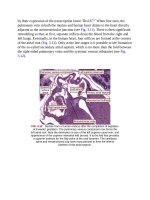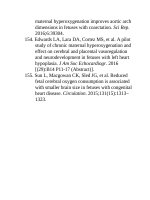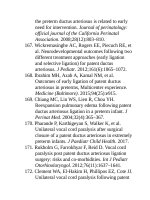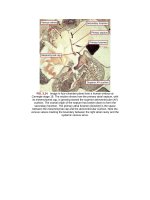Andersons pediatric cardiology 1112
Bạn đang xem bản rút gọn của tài liệu. Xem và tải ngay bản đầy đủ của tài liệu tại đây (109.32 KB, 3 trang )
FIG.42.11 Imagetakenfromanepiscopicdatasetofamousesacrificed
atembryonicday13.5.Theaorticroothasbeentransferredtotheleft
ventricle.Thedistalendsofthecushionsintheintermediatecomponentof
theoutflowtractarenowexcavatingtoformtheleafletsofthepulmonary
valve.Thissectionreplicatestheparasternallong-axisechocardiographic
cut.
Thewallsofthesinusesareformedbyadditionalingrowthofnonmyocardial
tissuesfromthesecondheartfield.Thesignificanceofthecellsderivedfromthe
neuralcrestwasdemonstratedbyexperimentalablationoftheneuralcrestinthe
chick.Thisresultedinfailureofseptationandpersistenceofacommonarterial
trunk.Thetissuesderivedfromthesecondheartfieldwerealsosubsequently
showntobeimportantindifferentiationandseparationoftheventricularoutflow
tracts.17Intermsofmaldevelopmentoftheoutflowtract,itisnowestablished
thatthebicuspidaorticvalvecanbeproducedeitherbyexuberantfusionofthe
peripheralcomponentsofthemajoroutflowcushionsorbyfusionoftheendof
oneofthemajorcushionswiththeintercalatedcushion,thusproducinga
conjoinedleaflet.18Itisalsofeasiblethatfailureofformationoftheintercalated
cushioncouldproduceavalvewithonlytwoleaflets.Thesameprocessesmust
becapableofproducingthepulmonaryvalvewithtwoleaflets.Stenosisofthe
pulmonaryvalve,however,developsasanacquiredconditionduringintrauterine
life.19Interrogationofthedevelopingfetushasnowshownhowprogressionof
stenosiscanproducepulmonaryvalvaratresiawithanintactventricularseptum.
Thedegreeofseverityofobstructionseenatbirththendependsontheextentof
theprocessduringgestation.Itisalsowellestablishedthatperipheralpulmonary
arterialstenosismaybecausedbycongenitalrubella.Comparablechangesare
alsoseeninrecognizablesyndromesofmalformation,suchasthesyndromesof
WilliamsandAlagille.
ClinicalDiagnosis
Presentation
Thepresentationofpulmonarystenosisdependsonageandseverity.Inthe
neonate,criticalpulmonarystenosispresentswithlife-threateningcyanosisand
atrial-levelright-to-leftshunting.Thedifferentialdiagnosiswouldincludeother
formsofneonatalcyanosis,includingtranspositionofthegreatvesselsandthe
variousformsofpulmonaryatresia.Suchpatientsarelikelytodependonthe
arterialducttoprovidetheflowofbloodtothelungs.Hencepalliationinthe
shortterm,bymaintainingductalpatencywithintravenousinfusionsof
prostaglandin,islifesavinguntilamoredefinitivediagnosiscanbemadeandan
appropriateinterventionplanned.
Outsideoftheneonatalperiod,mildormoderatepulmonarystenosisisnot
likelytocausemajorsymptoms,unlessthereareassociatedlesionsorother
factors.Forexample,patientswiththetypicalphenotypeofNoonansyndrome
mayhavedifficultywithfeedingandgainingweight,unassociatedinmostcases
withtheseverityofthepulmonarystenosis.
Discoveryofdiseaseofmildormoderateseverityismostlikelywhen
physicalsignsaredetectedduringconsultationsforothermatters,most
commonlywhenacardiacmurmurisheard.
Althoughsomepatientswithmildtomoderatepulmonaryvalvestenosismay
presentwithexertionaldyspnea,thismaynotnecessarilyberelatedtoinability
oftherightventricletoincreasethestrokevolumeacrossafixedright
ventricularoutflowtractobstructionbutinsteadmayrepresentthepatient's
physicaldeconditioning.WhileDeMeesterandcolleaguesfoundareducedpeak
workloadandpeakoxygenuptakeinastudyevaluating19adultswithmildto
moderatepulmonaryvalvestenosis,theyalsoidentifiedalowerbaselineheart
rateandheartratereserveaswellasalowerthresholdofworkloadreachedat
anaerobicthresholdandpeakexercisecomparedtohealthycontrols,suggesting
thatphysicaldeconditioningmayplayaroleinexplainingthesefindings.20,21
Thisisimportanttokeepinmindwhenpatientswithmildtomoderate
pulmonaryvalvestenosisarebeingmanagedsoastoavoidinappropriate
limitationsfromphysicalactivitiesandtoencouragethemtomaintainahealthy
lifestylewithregularexercise.Theabilitytoincreasecardiacoutputwith
exercisebeyondincreasingtheheartrateinpatientswithmildtomoderate









